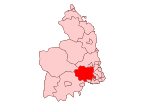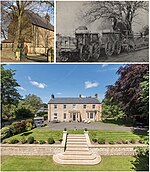Darras Hall railway station
1913 establishments in England1954 disestablishments in EnglandFormer North Eastern Railway (UK) stationsPages with no open date in Infobox stationRailway stations in Great Britain closed in 1929 ... and 2 more
Railway stations in Great Britain opened in 1913Use British English from December 2017

Darras Hall was a railway station on the Ponteland Railway, which ran between South Gosforth and Ponteland, with a sub-branch line to Darras Hall. The station served Darras Hall in Northumberland. The station was opened on 1 October 1913, by the North Eastern Railway. It consisted of a single timber platform, with a wooden building, and was located near to Broadway. In the mid- and late-1920s, an unscheduled service operated from Darras Hall for colliery workers at Belsay and Wallridge. The 7½-mile line, which linked with the Ponteland Railway, was known as the Wallridge Mineral Railway.
Excerpt from the Wikipedia article Darras Hall railway station (License: CC BY-SA 3.0, Authors, Images).Darras Hall railway station
Old Station Court,
Geographical coordinates (GPS) Address Nearby Places Show on map
Geographical coordinates (GPS)
| Latitude | Longitude |
|---|---|
| N 55.0374 ° | E -1.7641 ° |
Address
Old Station Court
Old Station Court
NE20 9PN , Darras Hall
England, United Kingdom
Open on Google Maps







